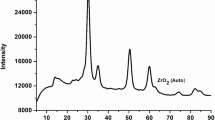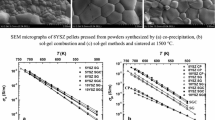Abstract
High-purity uniform powders of zirconia-based solid electrolytes stabilized with yttria (4 and 8 mol %) are synthesized by co-precipitation with subsequent annealing at different temperatures. The obtained powders were studied using X-ray analysis and transmission electron microscopy; the specific surface area was measured by nitrogen adsorption. The stabilized zirconia powder sintering was studied over temperature range from 1000 to 1600°C. The ionic conductivity of samples containing 8 mol % of yttria was 0.06–0.07 S/сm, that is comparable with that obtained with commercial solid electrolytes.
Similar content being viewed by others
References
Burmistrov, I.N., Agarkov, D.A., Bredikhin, S.I., Nepochatov, Yu.K., Tiunova, O.V., and Zadorozhnaya, O.Yu., Multilayered electrolyte-supported SOFC based on NEVZ-ceramics membrane, ECS Trans., 2013, vol. 57, no. 1, p. 917.
Suciu, C., Hoffmann, A.C., Vik, A., and Goga, F., Effect of calcination conditions and precursor proportions on the properties of YSZ nanoparticles obtained by modified sol–gel route, Chem. Eng. J., 2008, vol. 138, p. 608.
Pakharukova, V.P., Moroz, E.M., Zyuzin, D.A., Zaikovskii, V.I., Tuzikov, F.V., Kosmambetova, G.R., and Strizhak, P.E., Structure characterization of nanocrystalline yttria-stabilized zirconia powders prepared via microwave-assisted synthesis, J. Phys. Chem. C, 2012, vol. 116, p. 9762.
Srdic, V.V., Winterer, M., and Hahn, H., Sintering behavior of nanocrystalline zirconia prepared by chemical vapor synthesis, J. Amer. Ceram. Soc., 2000, vol. 83, no. 4, p. 729.
Kul’met’eva V.B., Porozova S.E., and Gnedina E.S., Synthesis of nanocrystalline zirconium dioxide stabilized with yttria for low-temperature sintering, Russ. J. Non-Ferr. Met., 2013, vol. 54, no. 3, p. 239.
Panthi, D., Hedayat, N., and Du, Y., A comparative study on the densification behavior of yttria-stabilized zirconia electrolyte powders, ECS Trans., 2017, vol. 78, no. 1, p. 327.
Gibson, I.R., Dransfield, G.P., and Irvine, J.T.S., Sinterability of commercial 8 mol % yttria-stabilized zirconia powders and the effect of sintered density on the ionic conductivity, J. Mater. Sci., 1998, vol. 33, no. 17, p. 4297.
Hotza, D., Garcia, D.E., and Castro, R.H.R., Obtaining highly dense YSZ nanoceramics by pressureless, unassisted sintering, Int. Mat. Rev., 2015, vol. 60, no. 7, p. 353.
Kuo, C.W., Shen, Y.H., Hung, I.M., Wen, S.B., Lee, H.E., and Wang, M.C., Effect of Y2O3 addition on the crystal growth and sintering behavior of YSZ nanopowders prepared by a sol–gel process, J. Alloy Compd., 2009, vol. 472, nos. 1–2, p. 186.
Karpyuk, P.V., Kuznetsova, D.E., Bogatov, K.B., and Dosovitskii, G.A. Determination of the YAG powder particle size distribution by laser diffraction method. Industrial Lab. Diagnostics Mater., 2017, vol. 83, no. 9, p. 35. (In Russian).
Nolze, G. and Kraus, W., Powder Cell—a program for the representation and manipulation of crystal structures and calculation of the resulting X-ray powder patterns, J. Appl. Cryst., 1996, vol. 29, p. 301.
Williamson, G.K. and Hall, W.H., X-ray line broadening from filed aluminium and wolfram, Acta Metall., 1953, vol. 1, no. 22, p. 22.
Lamas, D.G. and Walsoe de Reca, N.E., X-ray diffraction study of compositionally homogeneous, nanocrystalline yttria-doped zirconia powders, J. Mater. Sci., 2000, vol. 35, p. 5563.
Ingel, R.P. and Lewis, D., III, Lattice parameter and density for Y2O3-stabilized ZrO2, J. Amer. Ceram. Soc., 1986, vol. 69, no. 4, p. 325.
Argyriou, D.N. and Howard, C.J., Re-investigation of yttria-tetragonal zirconia polycrystal (Y-TZP) by neutron powder diffraction—a cautionary tale, J. Appl. Cryst., 1995, vol. 28, p. 206.
Minh, N.Q. and Takahashi, T., Science and Technology of Ceramic Fuel Cells, Amsterdam: Elsevier, 1995. p. 356.
Author information
Authors and Affiliations
Corresponding author
Additional information
Original Russian Text © P.S. Sokolov, P.V. Karpyuk, G.A. Dosovitskiy, P.A. Volkov, N.V. Lyskov, I.V. Slyusar’, A.E. Dosovitskiy, 2018, published in Elektrokhimiya, 2018, Vol. 54, No. 6, pp. 536–543.
Presented at the IV All-Russian Conference “Fuel Cells and Fuel Cell based Power Plants” (with international participation) June 25‒29, 2017, Suzdal, Vladimir region.
Rights and permissions
About this article
Cite this article
Sokolov, P.S., Karpyuk, P.V., Dosovitskiy, G.A. et al. Stabilized Zirconia-Based Nanostructured Powders for Solid-Oxide Fuel Cells. Russ J Electrochem 54, 464–470 (2018). https://doi.org/10.1134/S1023193518060162
Received:
Accepted:
Published:
Issue Date:
DOI: https://doi.org/10.1134/S1023193518060162




